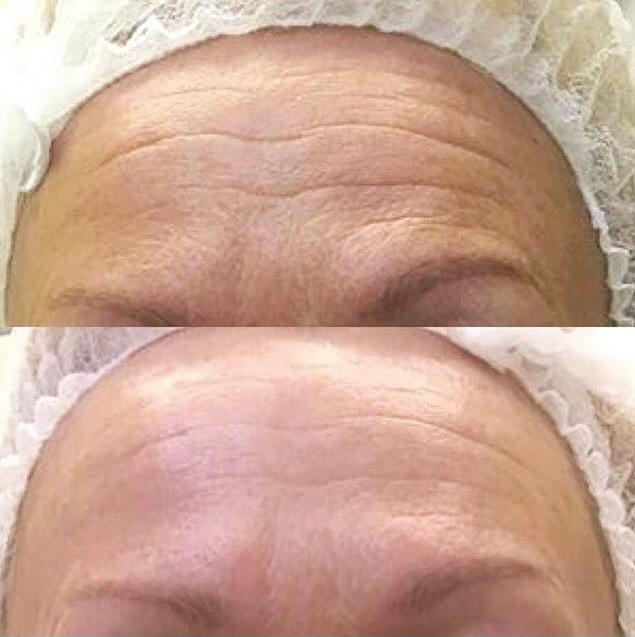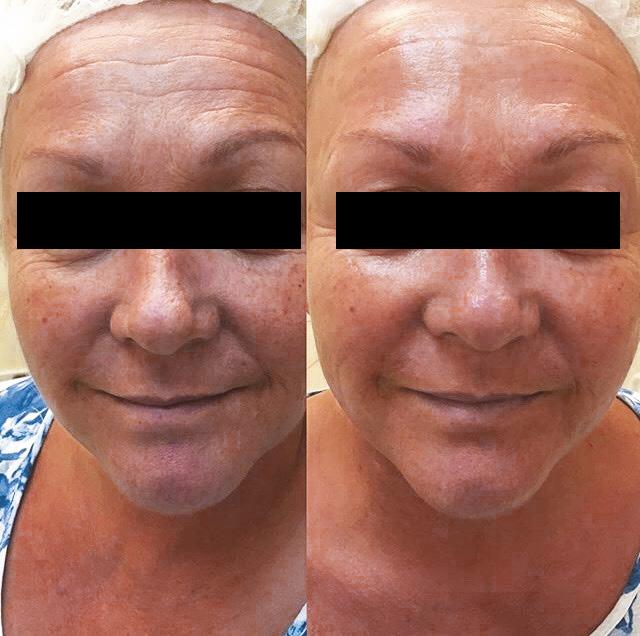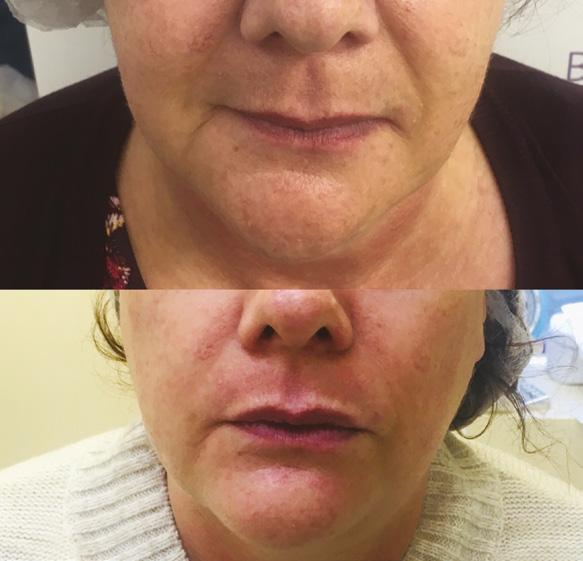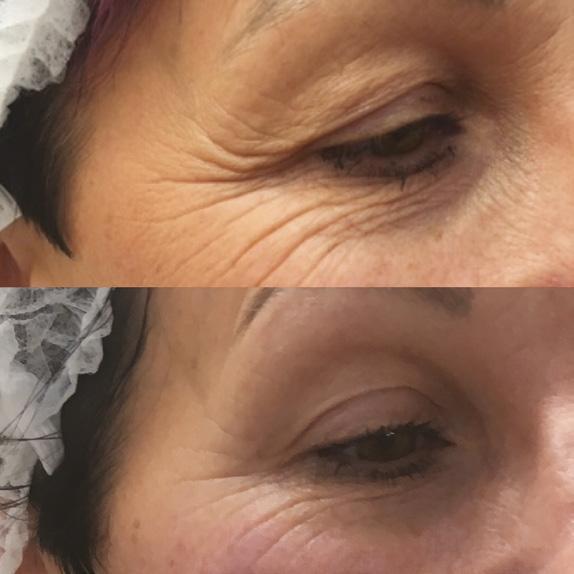
13 minute read
Offering Microcurrent Therapy
Aesthetic nurse Laura Rosser discusses the benefits of a microcurrent facial for skin rejuvenation
Microcurrent therapy, also known as electrotherapy or the microcurrent facial, is a treatment modality that is often overlooked by healthcare professionals as it is most commonly associated with the beauty industry. However, this article will explore how it can be used as a successful stand-alone treatment for patients who are apprehensive about undergoing more invasive procedures, and also how it can be utilised as an additional treatment for rejuvenating the skin.
Advertisement
History of microcurrent therapy Electrotherapy dates back to the ancient Egyptians. Existing medical papyri (ancient Egyptian texts) refer to the use of the ‘Nar’ fish – the Egyptian catfish – which was reportedly used to conduct electricity through the body to eliminate disease and cure common ailments including migraines, headaches and gout.1 This method of treatment captured the imaginations of many Greek and Latin writers, including Plato and Aristotle.1 One piece of work by the army surgeon of Emperor Nero insisted on an application of two to three live catfish to the head of the patient to cure migraines and headaches.2 As a treatment for gout, the sufferer was assisted to stand on a wet shoreline and receive electrotherapy, which would cause the entire foot to go numb, working its way up the tibia as far as the knee.2 In 1830, Italian physicist Dr Carlo Matteucci discovered that injured tissue in the human body discharged its own electricity3 and by the 1840s, Dr Matteucci shed light on the electrical properties of animal tissues. In fact, Dr Matteucci was the first to detect an electrical current in the heart4 and scientists have since expanded on this work to explore the benefits of electrotherapy in healthcare.3 The outcomes of one study published in 2003 on the treatment of leg ulcers with a microcurrent device showed the mean reduction of the wound surface of the ulcer was reduced by 95% after just eight weeks of treatment.5 It is widely believed that Dr Thomas Wing, a fifth generation Chinese physician who was treating patients for Bell’s palsy and facial pain in the 1970s, noticed that the faces of his subjects appeared smoother and they looked younger in appearance following their treatments.6 Evidence for the efficacy of physical therapies for the treatment of Bell’s palsy is lacking and a Cochrane systematic review of the efficacy of physical therapies concluded that there was no significant benefit in this treatment area;7 however, the ongoing findings relating to improvement in skin tone and appearance have continued. For example, a 2003 study conducted by Dr Emil Chi, the director of the department of pathology and chairman of the department of histopathology at the University of Washington Medical School, determined that when subjects’ skin tissue was treated with microcurrent technology, there was a 45% increase in the number of elastin fibres in the dermis and a 10% increase in collagen thickness in the connective tissues. The study also showed a 35% increase in blood circulation to treated areas and increased lymphatic drainage,8 all of which are the desired outcomes from a traditional microcurrent therapy facial.
What is microcurrent therapy and how does it work? The body has a continual flow of electrical impulses that transmit signals through tissues, via electrons, chemicals and electromagnetic bonds.9 Microcurrent technology offers a safe and effective way of reprogramming muscle fibres to lift and tone the muscles of the face and body. It has a long history of use in both the beauty industry and the field of physiotherapy with its harmlessness confirmed10 with use of transcutaneous electrical nerve stimulation (TENS) being widely used for musculoskeletal pain.11 One recent study suggested safety and efficacy of using microcurrent to the soles of the children’s feet to stimulate growth in short-stature individuals.12 Microcurrent lifts and tones the muscles by stimulating the Golgi tendon organ, which is present in every muscle in the body. It is a proprioceptor, which is adjacent to the myotendinous junction.13 Together with the muscle spindle fibres, the Golgi tendon organ is responsible for muscle tone.11 The microcurrents are delivered through a specific device with two handpieces, or wands; one that is positive and one negative. Different


settings can be used to achieve different outcomes. Lower frequency settings of around 0.8Hz allow for the microcurrent to penetrate more deeply through the skin and into the dermis to reach the muscle fibre and stimulate the lymph nodes. This can also provide a lymphatic drainage action, which reduces puffiness in areas where excess interstitial fluids can accumulate, such as the mid and lower face, under eyes and jawline. Microcurrent has also been shown to be effective in reducing swelling through lymphatic drainage following rhinoplasty surgery in a study conducted in 2016.14 The higher frequency settings (up to 600Hz) enable the current to act superficially to stimulate the epidermis, thus improving the condition and texture of the skin by contracting the muscle fibres and stimulating the circulatory skin to give an additional rejuvenating effect to the skin.15 When microcurrent is applied to the skin it also stimulates healing by restoring the natural flow of electrical impulse, blood flow and stimulates collagen and elastin production, as previously discussed. One study of 30 women under 45 years of age showed a marked reduction in facial lines and wrinkles, reduced acne scarring and reduction of scars from injury in participants treated with microcurrent technology, in addition to reducing active acnes.16 An additional benefit of microcurrent technology in the aesthetics field is the application of electroporation. This is an electrical technique that involves the application of high-voltage electrical impulses for very short durations to enhance the skin’s permeability. It does this by creating transient pores in the stratum corneum, therefore increasing permeability and the percutaneous absorption of drugs,17 or more commonly used in aesthetics, active topical ingredients to provide a rejuvenating effect on the skin. A conductive gel is used to transmit the electrical current through and over the skin’s surface, which can also be infused with beneficial ingredients. At my clinic, I use a mild alpha hydroxy acid (AHA) peel to speed up the cell renewal process, followed by a microcurrent gel with a blend of aloe vera, marine collagen and royal jelly. I find that this combination has an instant brightening and hydrating effect on the skin. A 2014 study has shown that a skincare regime involving AHAs and vitamins significantly improves the appearance of the skin, including wrinkles and skin texture, as well as elasticity, without significant adverse effects.18 A study explored the effects of aloe vera application with and without microcurrent therapy on the healing of surgically-induced wounds in rats. It indicated that the group treated with microcurrent plus aloe vera presented an earlier onset of the proliferative phase compared to the control group and animals treated with aloe vera gel alone. In both groups the number of fibroblasts and newly-formed vessels were much greater than the control group, indicating that both treatments are effective in their own right.19 Case studies


Before
After
Figure 1: 50-year-old patient before and after six microcurrent therapy sessions Case study 1 A 50-year-old patient desired overall facial rejuvenation, expressing particular dissatisfaction with the eye area and laxity of skin tissue in the upper eyelid. The patient underwent a course of six sessions, spaced seven to 10 days apart, to the full face with some extra time spent around the eye; approximately six to seven minutes per eye.
Case study 2 This 59-year-old patient expressed a desire for a more lifted facial appearance in the cheek area. Six sessions of microcurrent facial treatments were performed seven to 10 days apart. Results show a marked reduction in the nasolabial folds, as well as lifting and firming of the mid-face and rejuvenation and plumping to the perioral area.
Case study 3 This 60-year-old patient expressed a desire for overall skin rejuvenation, lifting and toning. A marked improvement could be seen after just one session of microcurrent using a lifting and toning action using two probes to physically lift and tighten the muscle, whilst adding an electrical impulse. A smoothing action was used with the probes to aid lymphatic drainage alongside a feathering technique. This technique involves passing smalltipped electrodes over the skin at a high frequency to stimulate circulation to the epidermis, which provides an electroporation effect when used in conjunction with topical products or a facemask. Smoothing of the forehead lines can be seen, in addition to overall improvement in hydration of the skin and reduction of hyperpigmentation. This patient went on to have a course of six treatments.
Before
After
Figure 2: 59-year-old patient before and after six microcurrent therapy sessions
Figure 3: 60-year-old patient before and immediately after one treatment of microcurrent therapy
Before After Before
After
Clinical practice As an aesthetic nurse who offers a wide range of non-surgical treatments, including skin treatments and more invasive injectable procedures, I find that there are a group of patients, and even potential patients, who are not yet ready to explore more invasive options such as toxin or dermal fillers. They are often people who fear the long-term outcomes of these treatments due to common misconceptions or they may even have needle phobia. It is beneficial to my practice that whilst educating this patient group in the efficacy of these treatments, I am also able to offer a safe, noninvasive, yet effective treatment that helps to gain my patient’s trust. Another benefit in addition to patient satisfaction is patient comfort. The majority of patients report that microcurrent therapy is very relaxing and state that they can see immediate results. Many also report that they can continue to feel an ongoing tightening experience of the skin up to three to four days after treatment. As with any treatment, some maintenance is required and I often compare the treatment to a gym workout for the face. Results can be seen after one session; however, I find that best results are seen with a regular treatment regime of around seven days apart for a course of between six to seven sessions. Some patients will come back every few weeks for a maintenance session, some will opt to have another course of treatment in a few months’ time. As with attending the gym, the more time you invest, the greater the results you will see. Some will occasionally go on to have injectable treatments, but will continue to have microcurrent facials as a way to improve their skin tone, reduce fine lines and puffiness, and to complement the results of injectables. Additional benefits I have discovered whilst incorporating this treatment into my aesthetic practice can be to improve facial asymmetry caused by muscle weakness. I have found that it can also reverse the effects of toxin treatment when a complication such as ptosis or brow heaviness has occurred as I find that microcurrent therapy can re-educate the muscle and give movement back.
Contraindications and side effects As with most treatments, pregnancy is contraindicated. Other contraindications include:20 • Epilepsy • Cancer • Photosensitive migraines • Patients with pacemaker • Extreme acne or rosacea • Metal plates or implants in the face • Botulinum toxin or dermal fillers in the two weeks prior to treatment
Microcurrent facials have very few side effects and I have not experienced any from my own patients. It is reported that some patients have experienced drowsiness and mild nausea following treatment. Hydration is recommended after treatment, and any negative symptoms usually pass within 12-24 hours.21
Conclusion Microcurrent therapy is a safe and effective rejuvenating treatment with a long history of research. It can be used in addition to more advanced aesthetic treatments or as a stand-alone treatment to offer re-contouring of the facial muscles, deep skin hydration and collagen synthesis. Microcurrent therapy can be offered as a non-invasive alternative to injectables to reduce the appearance of facial lines and wrinkles. It can also be used to treat mild acne, acne scarring and improve wound healing and has a deeply hydrating effect on the skin when topical products are incorporated into the treatment. In addition, microcurrent therapy provides lymphatic drainage by reducing interstitial fluid that causes puffiness and acts as a transmitter to aid product absorption through electroporation of medications or facial products.
Laura Rosser is an aesthetic nurse and founder of Belle Derma Aesthetics in South Wales, a Save Face and Acne and Rosacea Association-accredited clinic and treatment provider. Rosser has nine years’ experience as a registered nurse, four years in aesthetics and five years in the permanent makeup industry.
REFERENCES
1. Park Roz, ‘Ancient Egyptian Headaches: Ichthyo- or electrotherapy?’, Pharmacy & Medicine in Ancient Egypt. Proceedings of the conferences held in Cairo (2007) & Manchester (2008) ed. by
J.Cockitt & A.R. David B.A.R. Archeopress, Oxford (2010). 127-131, p.1,2 2. Park Roz, ‘Catfish Remedy for Gout in Ancient Egypt’ (Read at History of Ancient Medicine conference, Reading University. 2006), p.9 3. Bull. B.R ‘The electrophysiological work of Carlo MatteuccI’ (1996) Brain Research Bulletin
Volume 40, Issue 2, ;40(2). p.69-91 <https://www.sciencedirect.com/science/article/abs/ pii/0361923096000366?via%3Dihub> 4. Rogers Kara ‘Defibrillation- Health’ (2009) Britannica Enclopedia, p.1. <https://www.britannica.com/ science/defibrillation#ref1118183> 5. Wirsing PG et al., ‘Wireless microcurrent stimulation- an innovative electrical stimulation method for the treatment of patients with leg and diabetic foot ulcers’, International Wound Journal, 12 (2015) 693-698, p.1. 6. ‘The history of frequency-specific microcurrent’ Anaesthesia Key, (2016) <https://aneskey.com/thehistory-of-frequency-specific-microcurrent/> 7. Teixeira L.J, Soares B.G, Vieira V.P, Prado G.F. ‘Physical Therapy for Bell’s palsy (idiopathic facial palsy)’ Cochrane Database Systemic Review, 2008;3:CD006283. 8. Madigan-Fleck Erin, ‘The Physiological Effects of Microcurrent’, p.5 <https://www.dermascope.com/ treatments/the-physiological-effects-of-microcurrent> 9. Madigan-Fleck Erin, ‘The Physiological Effects of Microcurrent’, p.3. https://www.dermascope.com/ treatments/the-physiological-effects-of-microcurrent 10. Fatimeh Saniee et al., ‘Consider of Microcurrent’s effect to variation of Facial Wrinkle trend,
Randomized Clinical Trial study’, Journal of Life Science, 9, 2012, p.1186. 11. Yvonne Coldra et al. ‘ACPWH guidance on the safe use of Transcutaneous Electrical Nerve
Stimulation (TENS) for musculosketal pain during pregnancy’ (2007) < https://www.oaa-anaes.ac.uk/ assets/_managed/editor/File/PDF/info_for_mothers/TENS%20Statement%20JUNE%2007%20
ACPWH%20Final.pdf> [accessed 16 July 2019] 12. Arum Jung et al., ‘Efficacy and safety of microcurrent stimulation of acupoints on the sole of the foot of children with short stature in 25th percentile of height by age: A randomized controlled trial’, European Journal of Integrative Medicine (2016) Volume 8, Issue 2, p.122-127. <https://www. sciencedirect.com/science/article/abs/pii/S1876382015300330> 13. Enrico Marani and Egbert A.J.F Lakke ‘Peripheral Nervous System Topics’ The Human Nervous
System (Third edition, 2012). <https://www.sciencedirect.com/topics/neuroscience/golgi-tendonorgan> 14. Aleksanyan TA et al. ‘Treatment with the use of microcurrent lymphatic drainage physiotherapy during the postoperative period following rhinoplastic surgery’ Vestn Otorinolaringol. 2016; 81(5), p.50-53. <https://www.ncbi.nlm.nih.gov/pubmed/27876738> 15. Madigan-Fleck Erin, ‘The Physiological Effects of Microcurrent’, p.3 <https://www.dermascope.com/ treatments/the-physiological-effects-of-microcurrent> 16. Fatimeh Saniee et al., ‘Consider of Microcurrent’s effect to variation of Facial Wrinkle trend,
Randomized Clinical Trial study’, Journal of Life Science, 9, 2012, p.1184-1189. 17. Longsheng Hu and others ‘Ionophoretic Transdermal Drug Delivery’ Handbook of Non invasive
Drug Delivery Systems (2010). https://www.sciencedirect.com/topics/neuroscience/electroporation 18. Diana Tran et al. ‘An antiaging skin care system containing alpha hydroxy acids and vitamins improves the biomechanical parameters of facial skin’ (2014) Clinical Cosmetic and Investigatory
Dermatology. 2015; 8, p.9–17. <https://www.ncbi.nlm.nih.gov/pmc/articles/PMC4277239/> 19. Fernanda Aparecida Sampaio Mendonca et al., ‘Effects of the application of Aloe vera and microcurrent on the healing of wounds surgically induced in Wistar rats’, ACTA Cirurgica
Brasileira, vol.24 no.2 Sao Paulo (Mar/April 2009) <http://www.scielo.br/scielo.php?script=sci_ arttext&pid=S0102-86502009000200013> 20. Silhouette International ‘Non-Surgical Microcurrent Facial Lifting- Dermalift Microface Intense with Jaw sculpt, User Manual’ Silhouette International, Silhouette House (p. 6) <https:www. silhouettebeauty.com> 21. Author unknown (2018) ‘Microcurrent Facelift’ The Derm review <https://thedermreview.com/ microcurrent-facelift/>










